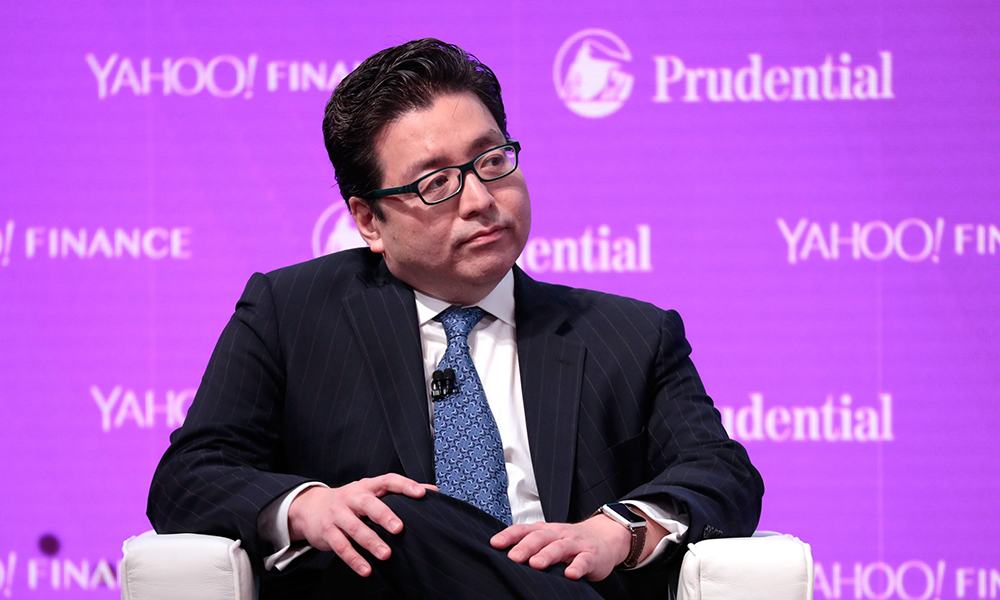
去年,,有少部分人預(yù)測(cè)股市將大漲,,F(xiàn)undstrat Global Advisors聯(lián)合創(chuàng)始人湯姆·李便是其中之一。當(dāng)時(shí),,其大部分同僚認(rèn)為,,經(jīng)濟(jì)衰退預(yù)期大行其道,股市將大跌,。
不過(guò),,他和美國(guó)經(jīng)濟(jì)證明,這些悲觀論者是錯(cuò)誤的,。事實(shí)上,,在彭博社(Bloomberg)調(diào)查的預(yù)測(cè)者當(dāng)中,湯姆2023年的預(yù)測(cè)是最準(zhǔn)確的,。
今年,,他再次做出預(yù)測(cè),并得到了驗(yàn)證,。6月初,,他稱標(biāo)普500指數(shù)將在月底突破5500點(diǎn)大關(guān)。6月21日收盤(pán)時(shí),,標(biāo)普500指數(shù)已經(jīng)達(dá)到5464.62點(diǎn),。
如今,他進(jìn)行了時(shí)間跨度更大的預(yù)測(cè),,令行業(yè)震驚:湯姆稱,,在2034年之前,標(biāo)普500指數(shù)或?qū)⑼黄?.5萬(wàn)點(diǎn)大關(guān),,相當(dāng)于超過(guò)170%的增幅,。
在彭博社6月18日錄制的最新一期《Odd Lots》播客節(jié)目中,他一開(kāi)始便解釋了自己的預(yù)測(cè)是有據(jù)可循的,,即歷史以及各類資產(chǎn)數(shù)據(jù),。他稱,債券市場(chǎng)比股市更聰明:“這也是為什么人們說(shuō),,股市是中等生的天堂,。”
他還認(rèn)為,,投資者無(wú)法與美聯(lián)儲(chǔ)(Federal Reserve)抗衡,,并將更多地關(guān)注推動(dòng)增長(zhǎng)的經(jīng)濟(jì)主題,例如:千禧一代如何重塑經(jīng)濟(jì),;全球勞動(dòng)力短缺將提振人工智能和科技行業(yè),;以及能源安全和網(wǎng)絡(luò)安全。湯姆稱,,通過(guò)選擇每個(gè)主題的最優(yōu)股,,他自2019年以來(lái)年年都跑贏了大盤(pán),。
他還表示,華爾街往往會(huì)低估新科技的影響力,,而最先采用這些科技的人群通常都是十幾和二十幾歲的年輕人,,同時(shí),大多數(shù)頂級(jí)投資專業(yè)人士都已40或50多歲,。他還提到,,手機(jī)在一開(kāi)始并未受到富人重視,而是被當(dāng)作玩具,。人工智能當(dāng)前的處境也是十分類似,。
“人工智能的采用率異常之高,不過(guò),,考慮到勞動(dòng)力短缺,,用例十分重要,”湯姆說(shuō),,“因此在我看來(lái),,我們很有可能低估了所有這些公司今后賺錢(qián)的能力?!?/p>
隨著勞動(dòng)力市場(chǎng)繼續(xù)保持供不應(yīng)求的狀態(tài),,人工智能將變得愈發(fā)重要。他預(yù)計(jì),,到2034年,,全球勞動(dòng)力短缺數(shù)量將達(dá)到約4000萬(wàn),相當(dāng)于約3萬(wàn)億美元的薪資支出,。他解釋說(shuō),,考慮到大多數(shù)自動(dòng)化都由半導(dǎo)體這類硬件支撐,這意味著這類芯片供應(yīng)商或?qū)⒛玫?萬(wàn)億美元的收入,。
湯姆表示,,科技股最終將占到全球股市權(quán)重的40-50%,而當(dāng)前為20%,。
“在這個(gè)回歸常態(tài)的世界中,,如果這是一個(gè)與人口結(jié)構(gòu)掛鉤的正常標(biāo)普周期,標(biāo)普有望在10年之內(nèi)達(dá)到1.5萬(wàn)點(diǎn),,稍后我可以用圖表說(shuō)明,,”他說(shuō),“從更長(zhǎng)的時(shí)間框架來(lái)看,,我覺(jué)得市場(chǎng)很有可能正在朝這個(gè)方向邁進(jìn),。”
股市已經(jīng)嚴(yán)重向科技和人工智能股傾斜,。今年,,僅英偉達(dá)(Nvidia)一家公司便貢獻(xiàn)了標(biāo)普500超過(guò)三分之一的市值增量。與此同時(shí),,華爾街正努力迎合市場(chǎng)無(wú)節(jié)制的漲勢(shì),,越來(lái)越多的分析師調(diào)高了其年終目標(biāo)。
上述漲勢(shì)和市場(chǎng)集中度讓人們開(kāi)始擔(dān)心,,人工智能熱是其泡沫即將破滅的信號(hào),。然而,湯姆對(duì)這些顧慮毫不在意,,并指出了人工智能與此前互聯(lián)網(wǎng)等產(chǎn)業(yè)泡沫生滅之間的關(guān)鍵區(qū)別,。
他表示,英偉達(dá)的競(jìng)爭(zhēng)優(yōu)勢(shì)要比互聯(lián)網(wǎng)熱初期的思科(Cisco)深厚得多,。他還指出,,與網(wǎng)絡(luò)泡沫不同的是,如今人工智能領(lǐng)域并沒(méi)有出現(xiàn)過(guò)度炒作的IPO行為,。
湯姆并非唯一一位做出大膽預(yù)測(cè)的華爾街看漲人士,。愛(ài)德華·雅德尼一直對(duì)下一個(gè)“狂飆20年代”超級(jí)周期深信不疑,而且稱標(biāo)普500指數(shù)明年將躍升至6000點(diǎn),。
他稱,,到2034年,標(biāo)普500指數(shù)可能會(huì)達(dá)到8000點(diǎn),,雖不及湯姆預(yù)測(cè)的高,,但漲幅依然高達(dá)46%,著實(shí)不錯(cuò),。(財(cái)富中文網(wǎng))
譯者:馮豐
審校:夏林
去年,,有少部分人預(yù)測(cè)股市將大漲,F(xiàn)undstrat Global Advisors聯(lián)合創(chuàng)始人湯姆·李便是其中之一,。當(dāng)時(shí),,其大部分同僚認(rèn)為,經(jīng)濟(jì)衰退預(yù)期大行其道,,股市將大跌,。
不過(guò),他和美國(guó)經(jīng)濟(jì)證明,,這些悲觀論者是錯(cuò)誤的,。事實(shí)上,在彭博社(Bloomberg)調(diào)查的預(yù)測(cè)者當(dāng)中,,湯姆2023年的預(yù)測(cè)是最準(zhǔn)確的,。
今年,他再次做出預(yù)測(cè),,并得到了驗(yàn)證,。6月初,,他稱標(biāo)普500指數(shù)將在月底突破5500點(diǎn)大關(guān)。6月21日收盤(pán)時(shí),,標(biāo)普500指數(shù)已經(jīng)達(dá)到5464.62點(diǎn),。
如今,他進(jìn)行了時(shí)間跨度更大的預(yù)測(cè),,令行業(yè)震驚:湯姆稱,,在2034年之前,標(biāo)普500指數(shù)或?qū)⑼黄?.5萬(wàn)點(diǎn)大關(guān),,相當(dāng)于超過(guò)170%的增幅,。
在彭博社6月18日錄制的最新一期《Odd Lots》播客節(jié)目中,他一開(kāi)始便解釋了自己的預(yù)測(cè)是有據(jù)可循的,,即歷史以及各類資產(chǎn)數(shù)據(jù),。他稱,債券市場(chǎng)比股市更聰明:“這也是為什么人們說(shuō),,股市是中等生的天堂,。”
他還認(rèn)為,,投資者無(wú)法與美聯(lián)儲(chǔ)(Federal Reserve)抗衡,,并將更多地關(guān)注推動(dòng)增長(zhǎng)的經(jīng)濟(jì)主題,例如:千禧一代如何重塑經(jīng)濟(jì),;全球勞動(dòng)力短缺將提振人工智能和科技行業(yè),;以及能源安全和網(wǎng)絡(luò)安全。湯姆稱,,通過(guò)選擇每個(gè)主題的最優(yōu)股,,他自2019年以來(lái)年年都跑贏了大盤(pán)。
他還表示,,華爾街往往會(huì)低估新科技的影響力,,而最先采用這些科技的人群通常都是十幾和二十幾歲的年輕人,同時(shí),,大多數(shù)頂級(jí)投資專業(yè)人士都已40或50多歲,。他還提到,手機(jī)在一開(kāi)始并未受到富人重視,,而是被當(dāng)作玩具,。人工智能當(dāng)前的處境也是十分類似。
“人工智能的采用率異常之高,,不過(guò),,考慮到勞動(dòng)力短缺,用例十分重要,”湯姆說(shuō),,“因此在我看來(lái),,我們很有可能低估了所有這些公司今后賺錢(qián)的能力?!?/p>
隨著勞動(dòng)力市場(chǎng)繼續(xù)保持供不應(yīng)求的狀態(tài),,人工智能將變得愈發(fā)重要,。他預(yù)計(jì),,到2034年,全球勞動(dòng)力短缺數(shù)量將達(dá)到約4000萬(wàn),,相當(dāng)于約3萬(wàn)億美元的薪資支出,。他解釋說(shuō),考慮到大多數(shù)自動(dòng)化都由半導(dǎo)體這類硬件支撐,,這意味著這類芯片供應(yīng)商或?qū)⒛玫?萬(wàn)億美元的收入,。
湯姆表示,科技股最終將占到全球股市權(quán)重的40-50%,,而當(dāng)前為20%,。
“在這個(gè)回歸常態(tài)的世界中,如果這是一個(gè)與人口結(jié)構(gòu)掛鉤的正常標(biāo)普周期,,標(biāo)普有望在10年之內(nèi)達(dá)到1.5萬(wàn)點(diǎn),,稍后我可以用圖表說(shuō)明,”他說(shuō),,“從更長(zhǎng)的時(shí)間框架來(lái)看,,我覺(jué)得市場(chǎng)很有可能正在朝這個(gè)方向邁進(jìn)?!?/p>
股市已經(jīng)嚴(yán)重向科技和人工智能股傾斜,。今年,僅英偉達(dá)(Nvidia)一家公司便貢獻(xiàn)了標(biāo)普500超過(guò)三分之一的市值增量,。與此同時(shí),,華爾街正努力迎合市場(chǎng)無(wú)節(jié)制的漲勢(shì),越來(lái)越多的分析師調(diào)高了其年終目標(biāo),。
上述漲勢(shì)和市場(chǎng)集中度讓人們開(kāi)始擔(dān)心,,人工智能熱是其泡沫即將破滅的信號(hào)。然而,,湯姆對(duì)這些顧慮毫不在意,,并指出了人工智能與此前互聯(lián)網(wǎng)等產(chǎn)業(yè)泡沫生滅之間的關(guān)鍵區(qū)別。
他表示,,英偉達(dá)的競(jìng)爭(zhēng)優(yōu)勢(shì)要比互聯(lián)網(wǎng)熱初期的思科(Cisco)深厚得多,。他還指出,與網(wǎng)絡(luò)泡沫不同的是,如今人工智能領(lǐng)域并沒(méi)有出現(xiàn)過(guò)度炒作的IPO行為,。
湯姆并非唯一一位做出大膽預(yù)測(cè)的華爾街看漲人士,。愛(ài)德華·雅德尼一直對(duì)下一個(gè)“狂飆20年代”超級(jí)周期深信不疑,而且稱標(biāo)普500指數(shù)明年將躍升至6000點(diǎn),。
他稱,,到2034年,標(biāo)普500指數(shù)可能會(huì)達(dá)到8000點(diǎn),,雖不及湯姆預(yù)測(cè)的高,,但漲幅依然高達(dá)46%,著實(shí)不錯(cuò),。(財(cái)富中文網(wǎng))
譯者:馮豐
審校:夏林
Fundstrat Global Advisors cofounder Tom Lee was among the few voices on Wall Street last year who predicted a stock market surge while most of his peers saw a slump amid widespread expectations for a recession.
But he—and the U.S. economy—proved the doomsayers wrong. In fact, among the forecasters surveyed by Bloomberg, Lee’s call in 2023 turned out to be the most accurate.
And this year, he’s still calling his shots and nailing them. In early June, he said the S&P 500 would hit 5,500 by the end of the month. As of Friday’s close, it was at 5,464.62.
Now, he’s got a longer-term forecast, and it’s a whopper: by the end of this decade, Lee said the S&P 500 could hit 15,000, representing upside of more than 170%.
On a recent episode of Bloomberg’s Odd Lots podcast, which was recorded on Tuesday, he began by explaining his evidence-based approach to forecasting, which looks across history and across assets. He said the bond market is smarter than the stock market: “That’s why they say equities are the land of C students.”
He also believes investors can’t fight the Federal Reserve and focuses more on themes that will drive growth, such as how millennials are reshaping the economy, the global labor shortage that will boost AI and tech stocks, as well as energy security and cybersecurity. By picking the strongest stocks within each theme, he has outperformed the market every year since 2019, Lee said.
Wall Street typically underestimates the impact of new technologies, which are usually adopted first by younger people in their teens and 20s while most top investment professionals are in their 40s and 50s, he added, noting that cell phones were initially dismissed as toys for the rich. Something similar is happening with AI.
“The adoption rate of AI is staggering, but the use case is important because there’s a labor shortage,” Lee said. “So to me, I think it’s very likely we’re underestimating how much revenue all these companies will make.”
And as the demand for workers continues to outstrip supply, AI will become more critical. By end of decade, he estimated the global labor shortage will be equivalent to 40 million workers, or about $3 trillion worth of wages. Considering that most of automation is from hardware like semiconductors, that means whoever is supplying the chips might have $2 trillion in revenue, he explained.
Eventually, technology will represent 40%-50% of global stock market weighting, up from about 20% today, Lee said.
“In a normalized world, if this is a normal S&P cycle following demographics, I could provide a chart later, S&P should be potentially 15,000 by the end of the decade,” he said. “As you move into longer timeframes, that’s probably where I think we’re moving towards.”
The stock market is already heavily concentrated on tech and AI stocks, with Nvidia alone accounting for more than a third of the S&P 500’s gains this year. Meanwhile, Wall Street is scrambling to keep up with the market’s relentless rally, with more analysts raising their year-end targets.
Such bullishness and market concentration have raised concerns that the AI hype is a sign of a bubble about to pop. But Lee downplayed those worries, pointing to key differences between earlier bubbles like the dot-com boom and bust.
He noted that Nvidia has a much steeper competitive advantage than Cisco did during the early stages of the internet boom. And unlike the dot-com bubble, there is a lack of overly hyped IPOs today, he added.
Lee isn’t the only Wall Street bull making bold predictions. Ed Yardeni has been pounding the table about another “Roaring 20s” super-cycle and has said the S&P 500 would jump to 6,000 by next year.
And by the end of the decade, he said the stock index could reach 8,000—not as high as Lee’s estimate but still good enough for a 46% jump.






